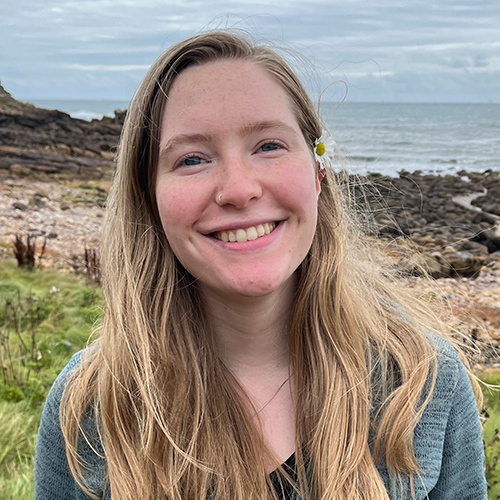Amy Sprague
February 22, 2024
An interview with Senna Keesing on her research with particle physics, submarine navigation and her Fellowship win.
A&A undergraduate Senna Keesing was selected to be a 2024 Brooke Owens Fellow. The fellowship committee selects only up to fifty students per year for their talent, experience, commitment to service and creativity. Fellows are matched with paid internships at leading aerospace companies and organizations and with senior and executive level mentors.
We interviewed Keesing on her interdisciplinary research here at the University, her internship this past summer at Lincoln Lab, her upcoming internship with Vast Space and her plans for the future.

Senna Keesing
First of all, congratulations on the Brooke Owens Fellowship. What a great validation of your research and hard work!
Thank you so much! This is an amazing opportunity and I’m so grateful to have been selected.
You are a researcher in the UW Axion Dark Matter eXperiment (ADMX), which aims to detect a hypothetical particle that could explain dark matter. What sparked your interest in this fascinating field of particle physics?
As a first year student at UW, I took two physics courses from Professor Gray Rybka. When he talked to the class about his research in particle physics, I was fascinated. I’ve always been interested in exploring the unknown, and what could be more unknown than dark matter? That summer, I approached him about working at his lab, ADMX, and I’ve been lucky enough to be part of the team ever since.
What are you working on for ADMX?
I’ve been working for almost a year now on a side experiment characterizing blackbody radiation and cavity resonance properties at low temperatures, which we’re hoping might clarify some of the data we’ve collected on the main ADMX experiment. Blackbody radiation is the name given to the phenomenon that makes warm objects radiate—it explains why a hot stove glows red, or why the sun is so bright. In physics, we understand this radiation pretty well, but some theories of new particles suggest that at low temperatures there will be small deviations to the equations that normally predict the amount of power radiated by these bodies.
So I’m conducting an experiment to search for these deviations by measuring the radiated microwave power from a resonant cavity and a resistor as they cool to liquid nitrogen temperatures. Standard physics predicts that these power values scale linearly with temperature, which is the expected result. However, some expanded standard model theories predict a deficit of power at low temperatures due to mixing of photons with new light particles. Hopefully, this research will help refine our understanding of blackbody radiation at low temperatures, including our understanding of the results from ADMX.
In your internship last summer at MIT’s Lincoln Lab, you contributed to the development of radar cross-section (RCS) modeling and analysis capabilities to enhance a celestial navigation system for submarines. Could you tell us more about this work and can you start by explaining that submarines navigate by the stars?
Certainly! The current navigation protocol for submarines involves updating position using GPS when the submarine is near the surface, and inertial navigation while it’s underwater—basically, pointing in a direction, going some distance, and tracking position just by doing the math. But the backup to the GPS system is currently a simple sextant, which, as you can imagine, is quite imprecise and difficult to use.
Lincoln Labs is currently developing a new backup navigation protocol whereby, when the submarine is at periscope depth, it can take a video of the night sky outside and compare the satellites it sees moving across the sky to onboard satellite catalogs, and use that information to generate a position fix.
Personally, I worked on propagating the satellite catalogs (which are based on sets of point-in-time position and velocity information) to predict where each satellite would be at the moment the submarine is looking at it, as well as which orbital factors might influence the accuracy of those predictions.
My work on RCS modeling, meanwhile, involved creating a range of analysis capabilities in MATLAB for determining how any particular object would appear to a radar system given its geometric and material properties. This “appearance” included the strength of the signal it would return, how it would appear over a wide spectrum of frequencies and aspect angles, the range-angle plot it would produce, and a whole host of other factors.
What will you be doing this summer for your internship with Vast Space?
Vast Space is working to develop an artificial-gravity space station.
As a part of that mission, I’ll be working on their guidance, navigation, and control (GNC) team. GNC is the subsystem that helps the spacecraft determine where it is, where it’s going, and how it’s going to get there. Beyond that, I’m not sure what my specific project will be, but I’m so excited to have the opportunity to work toward this mission!
From particle physics, submarine navigation by the stars, and aerospace engineering, you are developing a well-rounded education of the cosmos and how to maneuver in it. Do you know what you would ultimately like to focus on?
Based on these experiences, I think I’d like to work as an engineer doing controls for planetary probes, deep space missions—other really exploratory pursuits. I’m still compelled by that same fascination with the unknown, and finding a way to go and seek that knowledge is what drives me. Ultimately, I’d love to go to space as an astronaut, to continue working towards a deeper understanding of outer space and a more accessible universe for all!